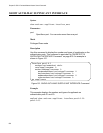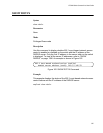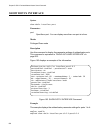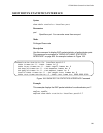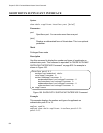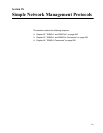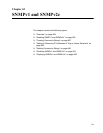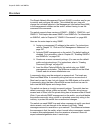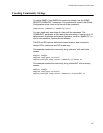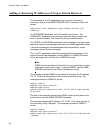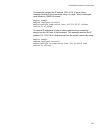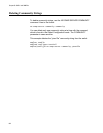
Chapter 62: SNMPv1 and SNMPv2c
934
Overview
The Simple Network Management Protocol (SNMP) is another way for you
to monitor and configure the switch. This method lets you view and
change the individual objects in the Management Information Base (MIB)
in the management software on the switch, without having to use the
command line commands.
The switch supports three versions of SNMP— SNMPv1, SNMPv2c, and
SNMPv3. This chapter discusses SNMPv1 and SNMPv2c. For information
on SNMPv3, refer to Chapter 64, ”SNMPv3 Commands” on page 969.
Here are the main steps to using SNMP:
Assign a management IP address to the switch. For instructions,
refer to Chapter 13, “IPv4 and IPv6 Management Addresses” on
page 257.
Activate SNMP management on the switch. The default setting is
disabled. For instructions, refer to Chapter 62, “Enabling SNMPv1
and SNMPv2c” on page 936.
Create one or more community strings. (You can use the default
public and private strings.) For instructions, refer to “Creating
Community Strings” on page 937.
Load the Allied Telesis MIBs for the switch onto your SNMP
management workstation. The MIBs are available from the Allied
Telesis web site at www.alliedtelesis.com.
A community string must be assigned an access level. The levels are
Read and Read/Write. A community string that has an access level of
Read can be used to view, but not change, the MIB objects on the switch.
A community string that has a Read/Write access level can be used to
both view the MIB objects and change them.
The switch can have up to eight community strings. The switch has two
default community strings: public and private. The public string has an
access level of Read, and the private string has an access mode of Read/
Write. If you activate SNMP management on the switch, you should delete
the private community string, which is a standard community string in the
industry, to protect the switch from unauthorized changes.
The switch can send SNMP trap and inform messages to notify you about
device events, such as changes in the states of port links. These
messages are sent to receivers on your network. The difference between
the messages is that the switch, when it sends inform messages, expects
to receive acknowledgements from the receivers, whereas it does not
expect acknowledgements when it sends traps.



